Business Law and Ethics: Contractual Relationships and Bhopal Disaster
VerifiedAdded on 2023/01/03
|11
|3811
|22
Report
AI Summary
This report provides a comprehensive overview of business law and ethics, beginning with an introduction to the importance of law and ethics in business operations. It delves into the intricacies of contract law, explaining the essentials of a valid contract, remedies for breach of contract, and concepts like counteroffers and promissory estoppel, illustrated with a case scenario involving a struggling artist and a tax consultant. The report then transitions to the Bhopal disaster, detailing the history of the Union Carbide India Limited (UCIL) plant, the events leading up to the 1984 gas leak, and the aftermath of the tragedy, including the legal and ethical implications. The report examines the causes and consequences of the disaster, highlighting the significance of safety regulations and corporate responsibility. The report concludes with a summary of the key takeaways and the importance of ethical conduct in business to prevent such disasters.
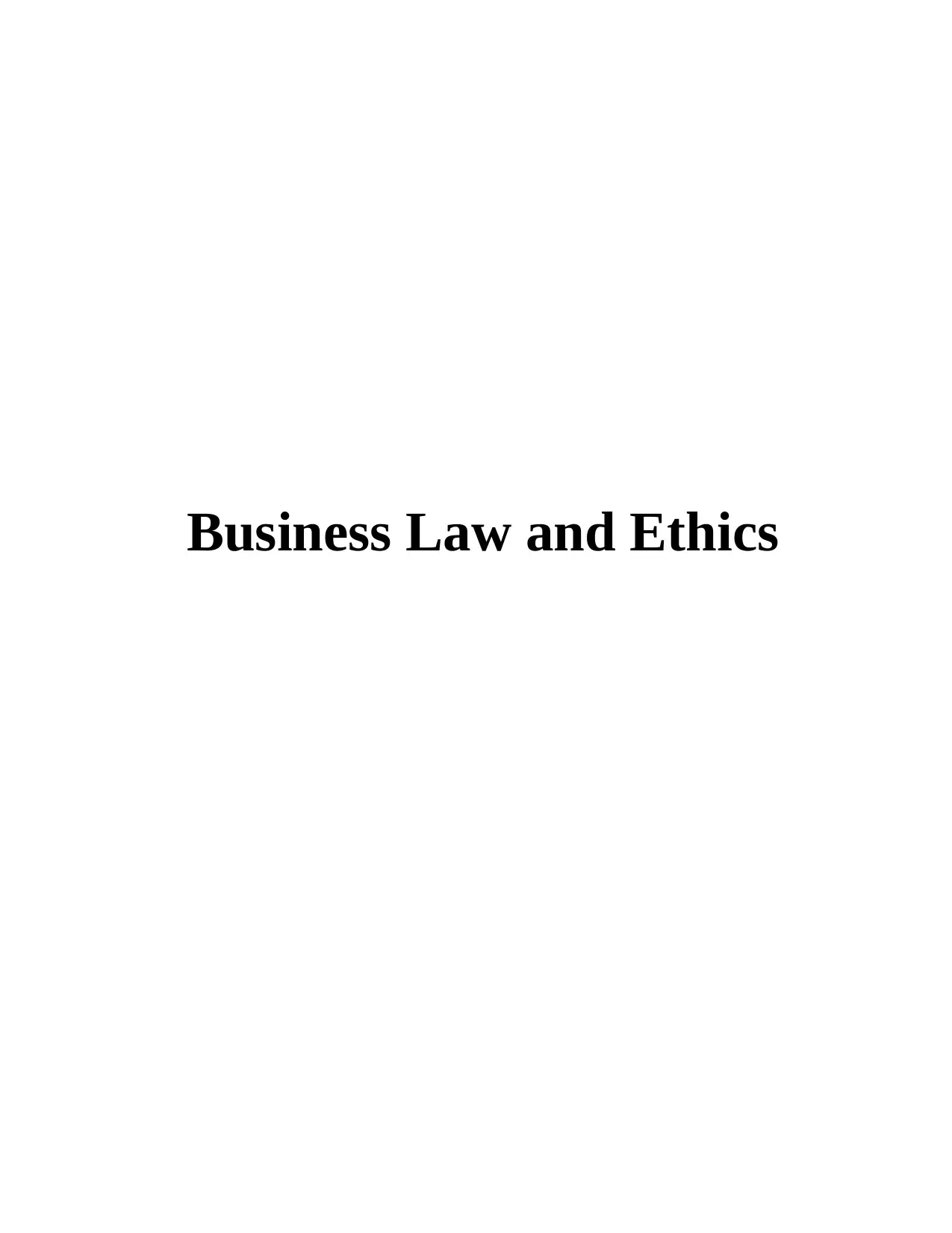
Business Law and Ethics
Paraphrase This Document
Need a fresh take? Get an instant paraphrase of this document with our AI Paraphraser
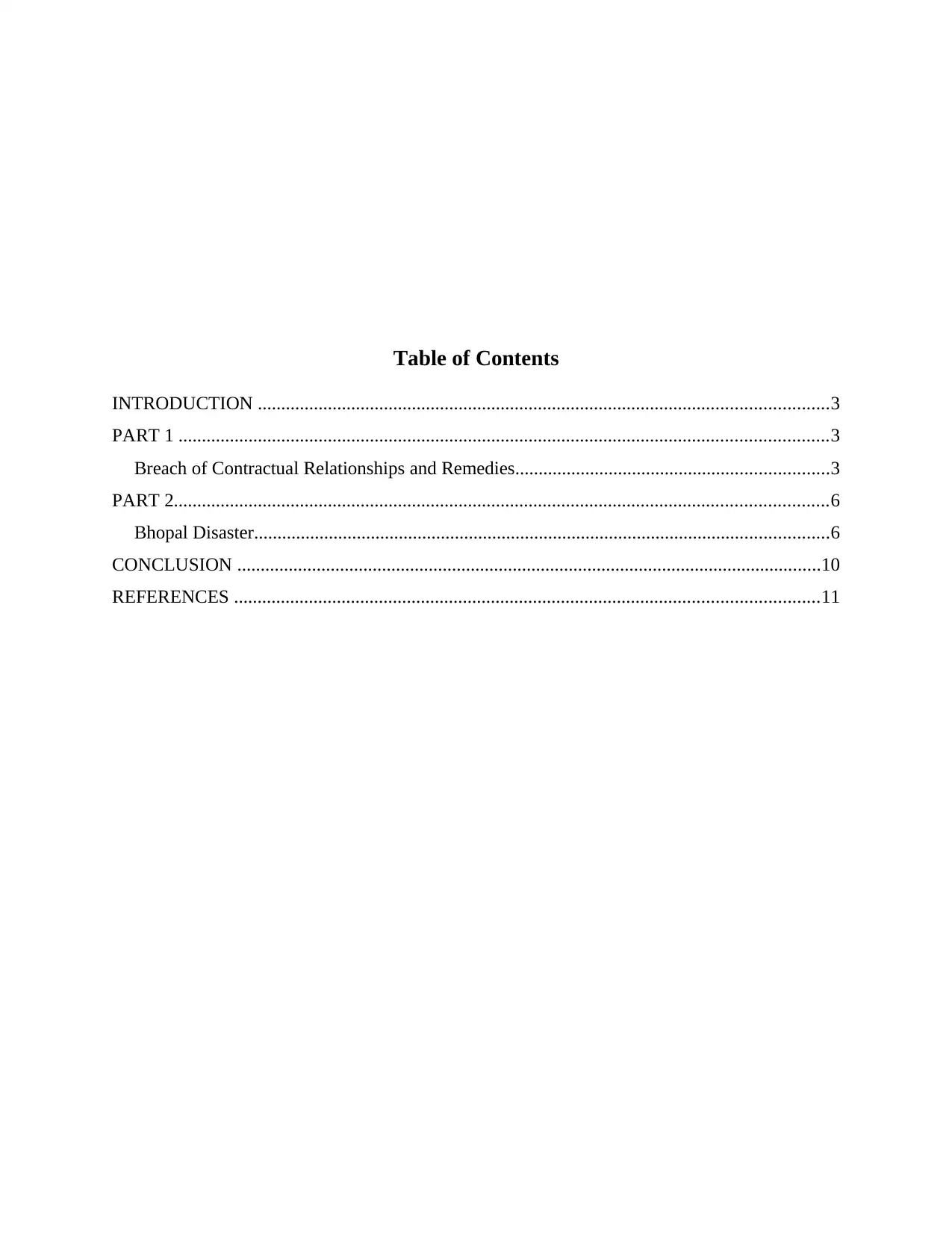
Table of Contents
INTRODUCTION ..........................................................................................................................3
PART 1 ...........................................................................................................................................3
Breach of Contractual Relationships and Remedies...................................................................3
PART 2............................................................................................................................................6
Bhopal Disaster...........................................................................................................................6
CONCLUSION .............................................................................................................................10
REFERENCES .............................................................................................................................11
INTRODUCTION ..........................................................................................................................3
PART 1 ...........................................................................................................................................3
Breach of Contractual Relationships and Remedies...................................................................3
PART 2............................................................................................................................................6
Bhopal Disaster...........................................................................................................................6
CONCLUSION .............................................................................................................................10
REFERENCES .............................................................................................................................11
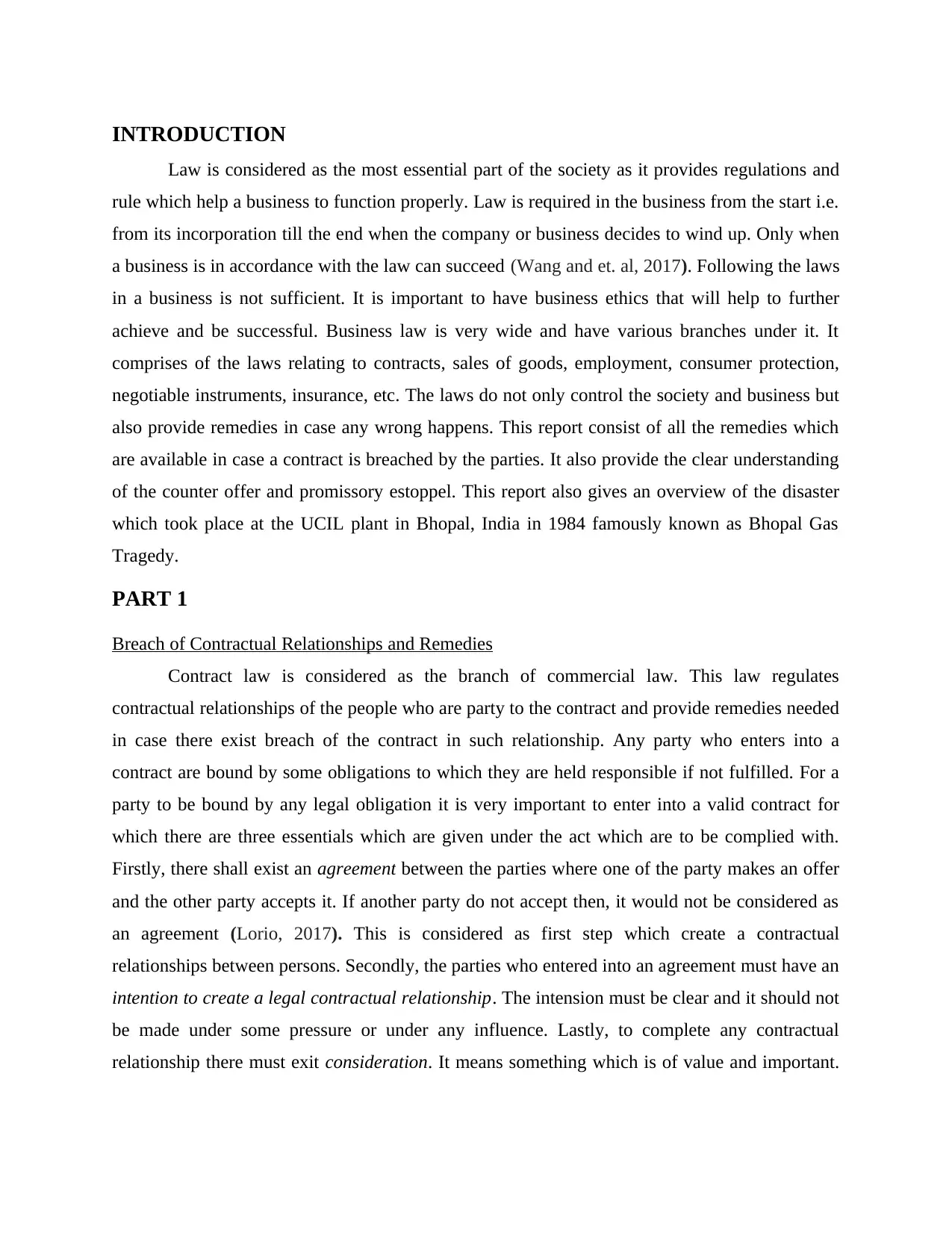
INTRODUCTION
Law is considered as the most essential part of the society as it provides regulations and
rule which help a business to function properly. Law is required in the business from the start i.e.
from its incorporation till the end when the company or business decides to wind up. Only when
a business is in accordance with the law can succeed (Wang and et. al, 2017). Following the laws
in a business is not sufficient. It is important to have business ethics that will help to further
achieve and be successful. Business law is very wide and have various branches under it. It
comprises of the laws relating to contracts, sales of goods, employment, consumer protection,
negotiable instruments, insurance, etc. The laws do not only control the society and business but
also provide remedies in case any wrong happens. This report consist of all the remedies which
are available in case a contract is breached by the parties. It also provide the clear understanding
of the counter offer and promissory estoppel. This report also gives an overview of the disaster
which took place at the UCIL plant in Bhopal, India in 1984 famously known as Bhopal Gas
Tragedy.
PART 1
Breach of Contractual Relationships and Remedies
Contract law is considered as the branch of commercial law. This law regulates
contractual relationships of the people who are party to the contract and provide remedies needed
in case there exist breach of the contract in such relationship. Any party who enters into a
contract are bound by some obligations to which they are held responsible if not fulfilled. For a
party to be bound by any legal obligation it is very important to enter into a valid contract for
which there are three essentials which are given under the act which are to be complied with.
Firstly, there shall exist an agreement between the parties where one of the party makes an offer
and the other party accepts it. If another party do not accept then, it would not be considered as
an agreement (Lorio, 2017). This is considered as first step which create a contractual
relationships between persons. Secondly, the parties who entered into an agreement must have an
intention to create a legal contractual relationship. The intension must be clear and it should not
be made under some pressure or under any influence. Lastly, to complete any contractual
relationship there must exit consideration. It means something which is of value and important.
Law is considered as the most essential part of the society as it provides regulations and
rule which help a business to function properly. Law is required in the business from the start i.e.
from its incorporation till the end when the company or business decides to wind up. Only when
a business is in accordance with the law can succeed (Wang and et. al, 2017). Following the laws
in a business is not sufficient. It is important to have business ethics that will help to further
achieve and be successful. Business law is very wide and have various branches under it. It
comprises of the laws relating to contracts, sales of goods, employment, consumer protection,
negotiable instruments, insurance, etc. The laws do not only control the society and business but
also provide remedies in case any wrong happens. This report consist of all the remedies which
are available in case a contract is breached by the parties. It also provide the clear understanding
of the counter offer and promissory estoppel. This report also gives an overview of the disaster
which took place at the UCIL plant in Bhopal, India in 1984 famously known as Bhopal Gas
Tragedy.
PART 1
Breach of Contractual Relationships and Remedies
Contract law is considered as the branch of commercial law. This law regulates
contractual relationships of the people who are party to the contract and provide remedies needed
in case there exist breach of the contract in such relationship. Any party who enters into a
contract are bound by some obligations to which they are held responsible if not fulfilled. For a
party to be bound by any legal obligation it is very important to enter into a valid contract for
which there are three essentials which are given under the act which are to be complied with.
Firstly, there shall exist an agreement between the parties where one of the party makes an offer
and the other party accepts it. If another party do not accept then, it would not be considered as
an agreement (Lorio, 2017). This is considered as first step which create a contractual
relationships between persons. Secondly, the parties who entered into an agreement must have an
intention to create a legal contractual relationship. The intension must be clear and it should not
be made under some pressure or under any influence. Lastly, to complete any contractual
relationship there must exit consideration. It means something which is of value and important.
⊘ This is a preview!⊘
Do you want full access?
Subscribe today to unlock all pages.

Trusted by 1+ million students worldwide
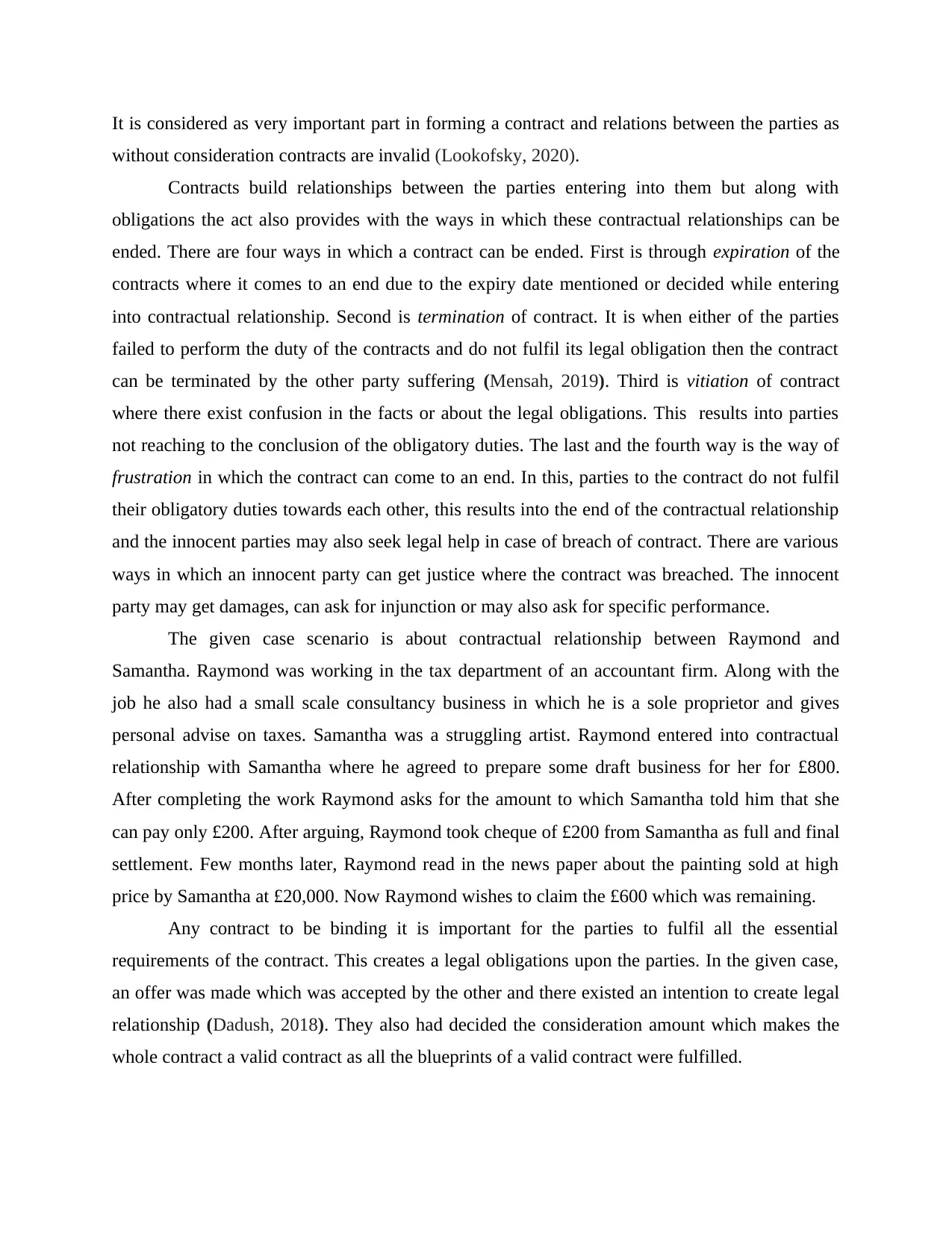
It is considered as very important part in forming a contract and relations between the parties as
without consideration contracts are invalid (Lookofsky, 2020).
Contracts build relationships between the parties entering into them but along with
obligations the act also provides with the ways in which these contractual relationships can be
ended. There are four ways in which a contract can be ended. First is through expiration of the
contracts where it comes to an end due to the expiry date mentioned or decided while entering
into contractual relationship. Second is termination of contract. It is when either of the parties
failed to perform the duty of the contracts and do not fulfil its legal obligation then the contract
can be terminated by the other party suffering (Mensah, 2019). Third is vitiation of contract
where there exist confusion in the facts or about the legal obligations. This results into parties
not reaching to the conclusion of the obligatory duties. The last and the fourth way is the way of
frustration in which the contract can come to an end. In this, parties to the contract do not fulfil
their obligatory duties towards each other, this results into the end of the contractual relationship
and the innocent parties may also seek legal help in case of breach of contract. There are various
ways in which an innocent party can get justice where the contract was breached. The innocent
party may get damages, can ask for injunction or may also ask for specific performance.
The given case scenario is about contractual relationship between Raymond and
Samantha. Raymond was working in the tax department of an accountant firm. Along with the
job he also had a small scale consultancy business in which he is a sole proprietor and gives
personal advise on taxes. Samantha was a struggling artist. Raymond entered into contractual
relationship with Samantha where he agreed to prepare some draft business for her for £800.
After completing the work Raymond asks for the amount to which Samantha told him that she
can pay only £200. After arguing, Raymond took cheque of £200 from Samantha as full and final
settlement. Few months later, Raymond read in the news paper about the painting sold at high
price by Samantha at £20,000. Now Raymond wishes to claim the £600 which was remaining.
Any contract to be binding it is important for the parties to fulfil all the essential
requirements of the contract. This creates a legal obligations upon the parties. In the given case,
an offer was made which was accepted by the other and there existed an intention to create legal
relationship (Dadush, 2018). They also had decided the consideration amount which makes the
whole contract a valid contract as all the blueprints of a valid contract were fulfilled.
without consideration contracts are invalid (Lookofsky, 2020).
Contracts build relationships between the parties entering into them but along with
obligations the act also provides with the ways in which these contractual relationships can be
ended. There are four ways in which a contract can be ended. First is through expiration of the
contracts where it comes to an end due to the expiry date mentioned or decided while entering
into contractual relationship. Second is termination of contract. It is when either of the parties
failed to perform the duty of the contracts and do not fulfil its legal obligation then the contract
can be terminated by the other party suffering (Mensah, 2019). Third is vitiation of contract
where there exist confusion in the facts or about the legal obligations. This results into parties
not reaching to the conclusion of the obligatory duties. The last and the fourth way is the way of
frustration in which the contract can come to an end. In this, parties to the contract do not fulfil
their obligatory duties towards each other, this results into the end of the contractual relationship
and the innocent parties may also seek legal help in case of breach of contract. There are various
ways in which an innocent party can get justice where the contract was breached. The innocent
party may get damages, can ask for injunction or may also ask for specific performance.
The given case scenario is about contractual relationship between Raymond and
Samantha. Raymond was working in the tax department of an accountant firm. Along with the
job he also had a small scale consultancy business in which he is a sole proprietor and gives
personal advise on taxes. Samantha was a struggling artist. Raymond entered into contractual
relationship with Samantha where he agreed to prepare some draft business for her for £800.
After completing the work Raymond asks for the amount to which Samantha told him that she
can pay only £200. After arguing, Raymond took cheque of £200 from Samantha as full and final
settlement. Few months later, Raymond read in the news paper about the painting sold at high
price by Samantha at £20,000. Now Raymond wishes to claim the £600 which was remaining.
Any contract to be binding it is important for the parties to fulfil all the essential
requirements of the contract. This creates a legal obligations upon the parties. In the given case,
an offer was made which was accepted by the other and there existed an intention to create legal
relationship (Dadush, 2018). They also had decided the consideration amount which makes the
whole contract a valid contract as all the blueprints of a valid contract were fulfilled.
Paraphrase This Document
Need a fresh take? Get an instant paraphrase of this document with our AI Paraphraser
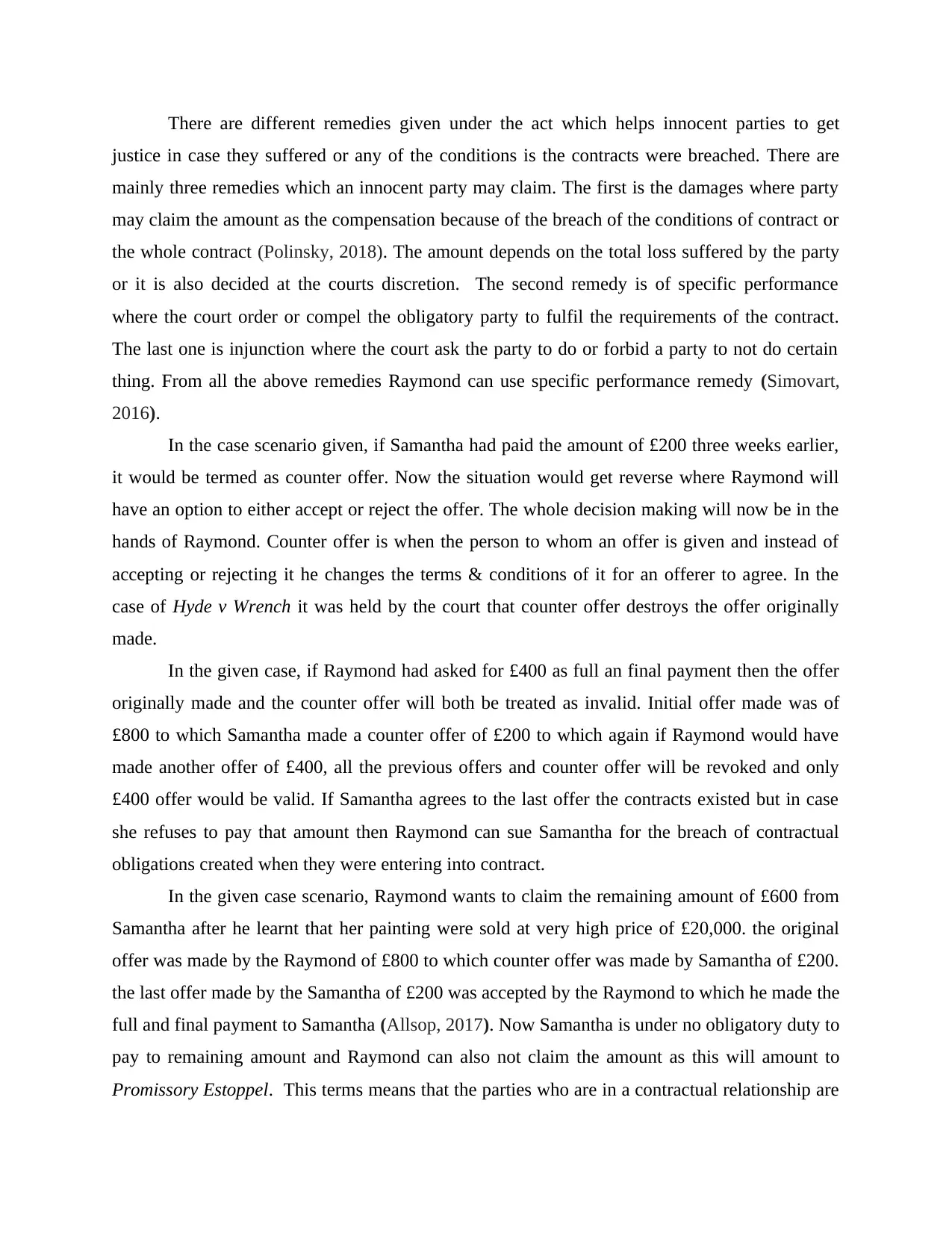
There are different remedies given under the act which helps innocent parties to get
justice in case they suffered or any of the conditions is the contracts were breached. There are
mainly three remedies which an innocent party may claim. The first is the damages where party
may claim the amount as the compensation because of the breach of the conditions of contract or
the whole contract (Polinsky, 2018). The amount depends on the total loss suffered by the party
or it is also decided at the courts discretion. The second remedy is of specific performance
where the court order or compel the obligatory party to fulfil the requirements of the contract.
The last one is injunction where the court ask the party to do or forbid a party to not do certain
thing. From all the above remedies Raymond can use specific performance remedy (Simovart,
2016).
In the case scenario given, if Samantha had paid the amount of £200 three weeks earlier,
it would be termed as counter offer. Now the situation would get reverse where Raymond will
have an option to either accept or reject the offer. The whole decision making will now be in the
hands of Raymond. Counter offer is when the person to whom an offer is given and instead of
accepting or rejecting it he changes the terms & conditions of it for an offerer to agree. In the
case of Hyde v Wrench it was held by the court that counter offer destroys the offer originally
made.
In the given case, if Raymond had asked for £400 as full an final payment then the offer
originally made and the counter offer will both be treated as invalid. Initial offer made was of
£800 to which Samantha made a counter offer of £200 to which again if Raymond would have
made another offer of £400, all the previous offers and counter offer will be revoked and only
£400 offer would be valid. If Samantha agrees to the last offer the contracts existed but in case
she refuses to pay that amount then Raymond can sue Samantha for the breach of contractual
obligations created when they were entering into contract.
In the given case scenario, Raymond wants to claim the remaining amount of £600 from
Samantha after he learnt that her painting were sold at very high price of £20,000. the original
offer was made by the Raymond of £800 to which counter offer was made by Samantha of £200.
the last offer made by the Samantha of £200 was accepted by the Raymond to which he made the
full and final payment to Samantha (Allsop, 2017). Now Samantha is under no obligatory duty to
pay to remaining amount and Raymond can also not claim the amount as this will amount to
Promissory Estoppel. This terms means that the parties who are in a contractual relationship are
justice in case they suffered or any of the conditions is the contracts were breached. There are
mainly three remedies which an innocent party may claim. The first is the damages where party
may claim the amount as the compensation because of the breach of the conditions of contract or
the whole contract (Polinsky, 2018). The amount depends on the total loss suffered by the party
or it is also decided at the courts discretion. The second remedy is of specific performance
where the court order or compel the obligatory party to fulfil the requirements of the contract.
The last one is injunction where the court ask the party to do or forbid a party to not do certain
thing. From all the above remedies Raymond can use specific performance remedy (Simovart,
2016).
In the case scenario given, if Samantha had paid the amount of £200 three weeks earlier,
it would be termed as counter offer. Now the situation would get reverse where Raymond will
have an option to either accept or reject the offer. The whole decision making will now be in the
hands of Raymond. Counter offer is when the person to whom an offer is given and instead of
accepting or rejecting it he changes the terms & conditions of it for an offerer to agree. In the
case of Hyde v Wrench it was held by the court that counter offer destroys the offer originally
made.
In the given case, if Raymond had asked for £400 as full an final payment then the offer
originally made and the counter offer will both be treated as invalid. Initial offer made was of
£800 to which Samantha made a counter offer of £200 to which again if Raymond would have
made another offer of £400, all the previous offers and counter offer will be revoked and only
£400 offer would be valid. If Samantha agrees to the last offer the contracts existed but in case
she refuses to pay that amount then Raymond can sue Samantha for the breach of contractual
obligations created when they were entering into contract.
In the given case scenario, Raymond wants to claim the remaining amount of £600 from
Samantha after he learnt that her painting were sold at very high price of £20,000. the original
offer was made by the Raymond of £800 to which counter offer was made by Samantha of £200.
the last offer made by the Samantha of £200 was accepted by the Raymond to which he made the
full and final payment to Samantha (Allsop, 2017). Now Samantha is under no obligatory duty to
pay to remaining amount and Raymond can also not claim the amount as this will amount to
Promissory Estoppel. This terms means that the parties who are in a contractual relationship are
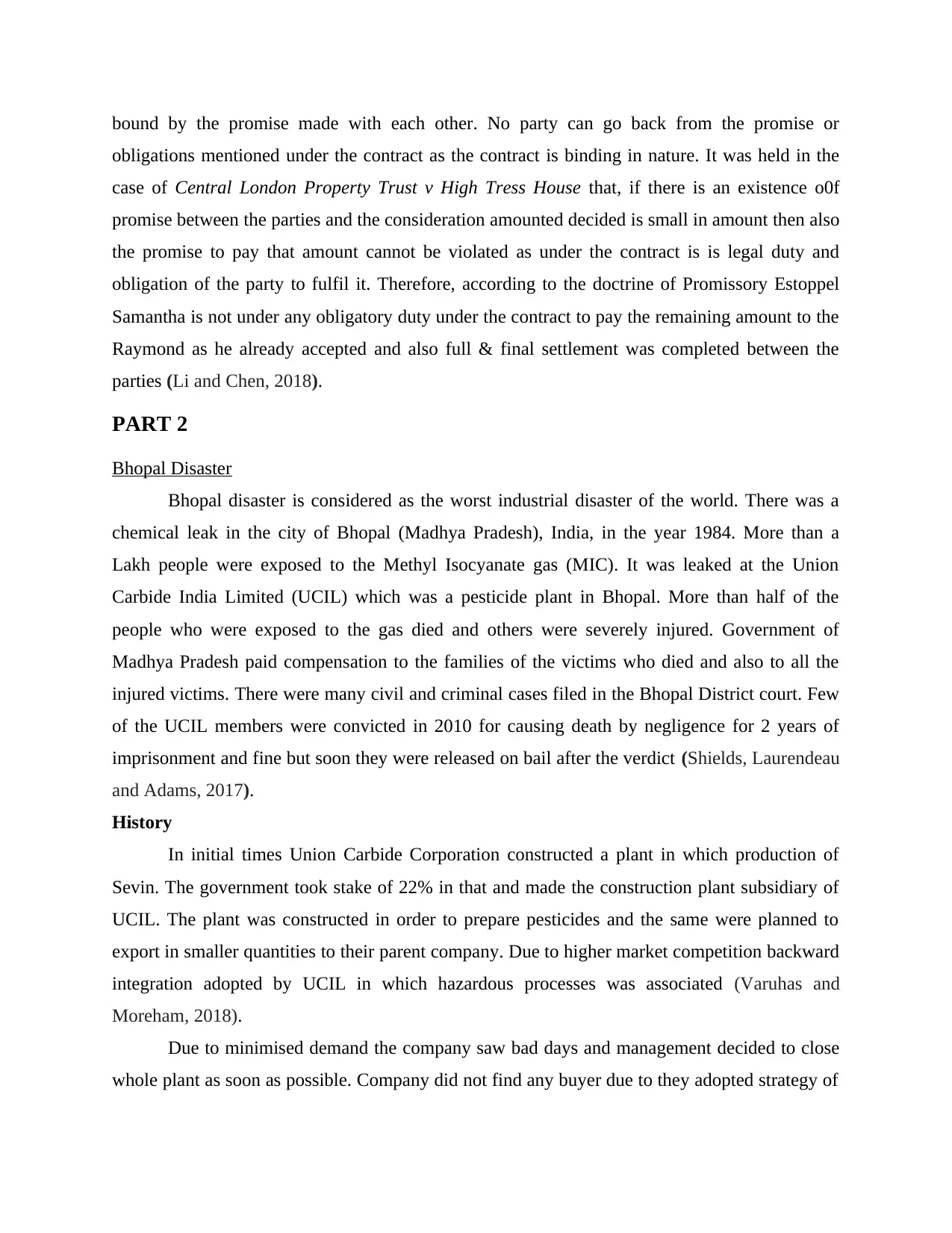
bound by the promise made with each other. No party can go back from the promise or
obligations mentioned under the contract as the contract is binding in nature. It was held in the
case of Central London Property Trust v High Tress House that, if there is an existence o0f
promise between the parties and the consideration amounted decided is small in amount then also
the promise to pay that amount cannot be violated as under the contract is is legal duty and
obligation of the party to fulfil it. Therefore, according to the doctrine of Promissory Estoppel
Samantha is not under any obligatory duty under the contract to pay the remaining amount to the
Raymond as he already accepted and also full & final settlement was completed between the
parties (Li and Chen, 2018).
PART 2
Bhopal Disaster
Bhopal disaster is considered as the worst industrial disaster of the world. There was a
chemical leak in the city of Bhopal (Madhya Pradesh), India, in the year 1984. More than a
Lakh people were exposed to the Methyl Isocyanate gas (MIC). It was leaked at the Union
Carbide India Limited (UCIL) which was a pesticide plant in Bhopal. More than half of the
people who were exposed to the gas died and others were severely injured. Government of
Madhya Pradesh paid compensation to the families of the victims who died and also to all the
injured victims. There were many civil and criminal cases filed in the Bhopal District court. Few
of the UCIL members were convicted in 2010 for causing death by negligence for 2 years of
imprisonment and fine but soon they were released on bail after the verdict (Shields, Laurendeau
and Adams, 2017).
History
In initial times Union Carbide Corporation constructed a plant in which production of
Sevin. The government took stake of 22% in that and made the construction plant subsidiary of
UCIL. The plant was constructed in order to prepare pesticides and the same were planned to
export in smaller quantities to their parent company. Due to higher market competition backward
integration adopted by UCIL in which hazardous processes was associated (Varuhas and
Moreham, 2018).
Due to minimised demand the company saw bad days and management decided to close
whole plant as soon as possible. Company did not find any buyer due to they adopted strategy of
obligations mentioned under the contract as the contract is binding in nature. It was held in the
case of Central London Property Trust v High Tress House that, if there is an existence o0f
promise between the parties and the consideration amounted decided is small in amount then also
the promise to pay that amount cannot be violated as under the contract is is legal duty and
obligation of the party to fulfil it. Therefore, according to the doctrine of Promissory Estoppel
Samantha is not under any obligatory duty under the contract to pay the remaining amount to the
Raymond as he already accepted and also full & final settlement was completed between the
parties (Li and Chen, 2018).
PART 2
Bhopal Disaster
Bhopal disaster is considered as the worst industrial disaster of the world. There was a
chemical leak in the city of Bhopal (Madhya Pradesh), India, in the year 1984. More than a
Lakh people were exposed to the Methyl Isocyanate gas (MIC). It was leaked at the Union
Carbide India Limited (UCIL) which was a pesticide plant in Bhopal. More than half of the
people who were exposed to the gas died and others were severely injured. Government of
Madhya Pradesh paid compensation to the families of the victims who died and also to all the
injured victims. There were many civil and criminal cases filed in the Bhopal District court. Few
of the UCIL members were convicted in 2010 for causing death by negligence for 2 years of
imprisonment and fine but soon they were released on bail after the verdict (Shields, Laurendeau
and Adams, 2017).
History
In initial times Union Carbide Corporation constructed a plant in which production of
Sevin. The government took stake of 22% in that and made the construction plant subsidiary of
UCIL. The plant was constructed in order to prepare pesticides and the same were planned to
export in smaller quantities to their parent company. Due to higher market competition backward
integration adopted by UCIL in which hazardous processes was associated (Varuhas and
Moreham, 2018).
Due to minimised demand the company saw bad days and management decided to close
whole plant as soon as possible. Company did not find any buyer due to they adopted strategy of
⊘ This is a preview!⊘
Do you want full access?
Subscribe today to unlock all pages.

Trusted by 1+ million students worldwide
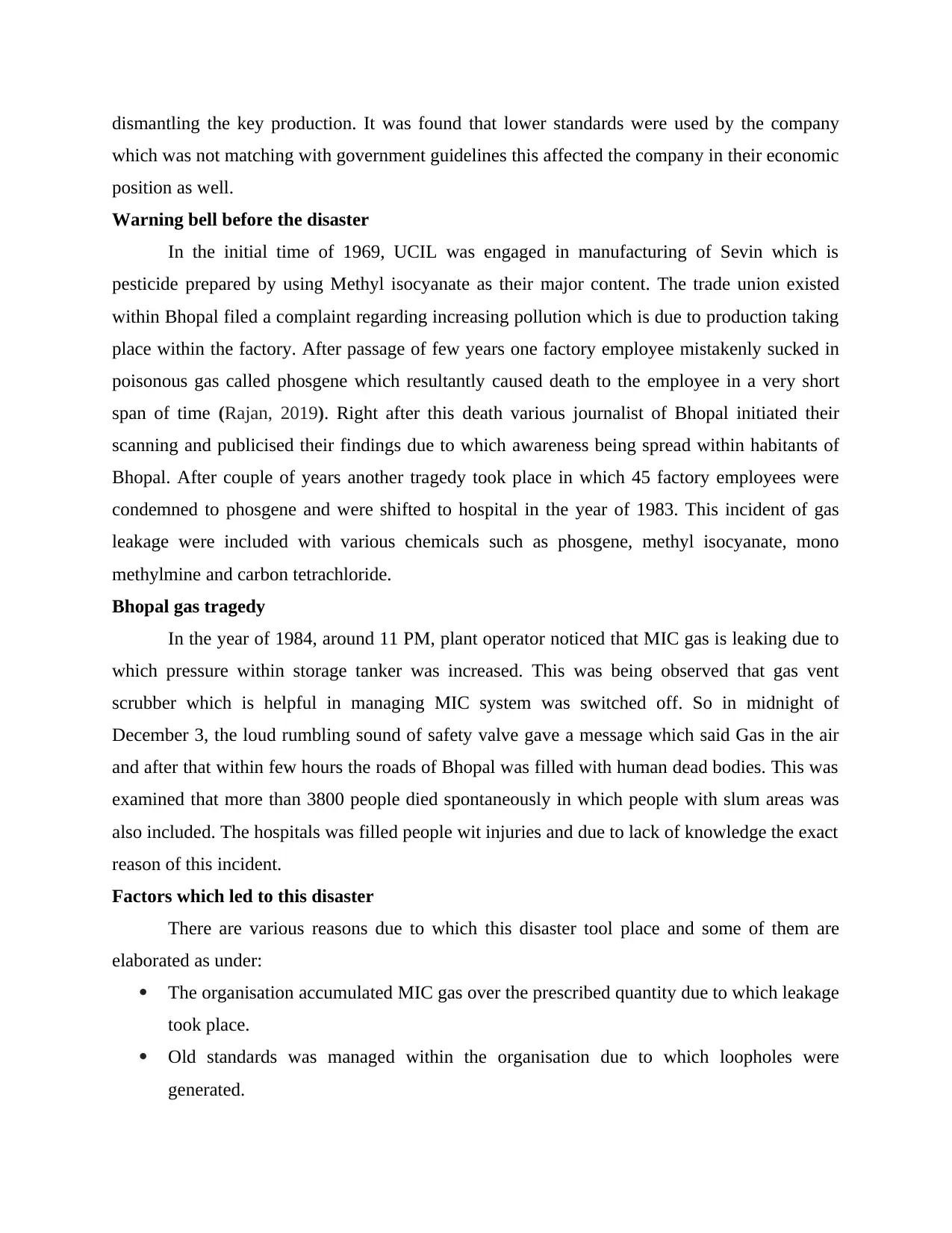
dismantling the key production. It was found that lower standards were used by the company
which was not matching with government guidelines this affected the company in their economic
position as well.
Warning bell before the disaster
In the initial time of 1969, UCIL was engaged in manufacturing of Sevin which is
pesticide prepared by using Methyl isocyanate as their major content. The trade union existed
within Bhopal filed a complaint regarding increasing pollution which is due to production taking
place within the factory. After passage of few years one factory employee mistakenly sucked in
poisonous gas called phosgene which resultantly caused death to the employee in a very short
span of time (Rajan, 2019). Right after this death various journalist of Bhopal initiated their
scanning and publicised their findings due to which awareness being spread within habitants of
Bhopal. After couple of years another tragedy took place in which 45 factory employees were
condemned to phosgene and were shifted to hospital in the year of 1983. This incident of gas
leakage were included with various chemicals such as phosgene, methyl isocyanate, mono
methylmine and carbon tetrachloride.
Bhopal gas tragedy
In the year of 1984, around 11 PM, plant operator noticed that MIC gas is leaking due to
which pressure within storage tanker was increased. This was being observed that gas vent
scrubber which is helpful in managing MIC system was switched off. So in midnight of
December 3, the loud rumbling sound of safety valve gave a message which said Gas in the air
and after that within few hours the roads of Bhopal was filled with human dead bodies. This was
examined that more than 3800 people died spontaneously in which people with slum areas was
also included. The hospitals was filled people wit injuries and due to lack of knowledge the exact
reason of this incident.
Factors which led to this disaster
There are various reasons due to which this disaster tool place and some of them are
elaborated as under:
The organisation accumulated MIC gas over the prescribed quantity due to which leakage
took place.
Old standards was managed within the organisation due to which loopholes were
generated.
which was not matching with government guidelines this affected the company in their economic
position as well.
Warning bell before the disaster
In the initial time of 1969, UCIL was engaged in manufacturing of Sevin which is
pesticide prepared by using Methyl isocyanate as their major content. The trade union existed
within Bhopal filed a complaint regarding increasing pollution which is due to production taking
place within the factory. After passage of few years one factory employee mistakenly sucked in
poisonous gas called phosgene which resultantly caused death to the employee in a very short
span of time (Rajan, 2019). Right after this death various journalist of Bhopal initiated their
scanning and publicised their findings due to which awareness being spread within habitants of
Bhopal. After couple of years another tragedy took place in which 45 factory employees were
condemned to phosgene and were shifted to hospital in the year of 1983. This incident of gas
leakage were included with various chemicals such as phosgene, methyl isocyanate, mono
methylmine and carbon tetrachloride.
Bhopal gas tragedy
In the year of 1984, around 11 PM, plant operator noticed that MIC gas is leaking due to
which pressure within storage tanker was increased. This was being observed that gas vent
scrubber which is helpful in managing MIC system was switched off. So in midnight of
December 3, the loud rumbling sound of safety valve gave a message which said Gas in the air
and after that within few hours the roads of Bhopal was filled with human dead bodies. This was
examined that more than 3800 people died spontaneously in which people with slum areas was
also included. The hospitals was filled people wit injuries and due to lack of knowledge the exact
reason of this incident.
Factors which led to this disaster
There are various reasons due to which this disaster tool place and some of them are
elaborated as under:
The organisation accumulated MIC gas over the prescribed quantity due to which leakage
took place.
Old standards was managed within the organisation due to which loopholes were
generated.
Paraphrase This Document
Need a fresh take? Get an instant paraphrase of this document with our AI Paraphraser
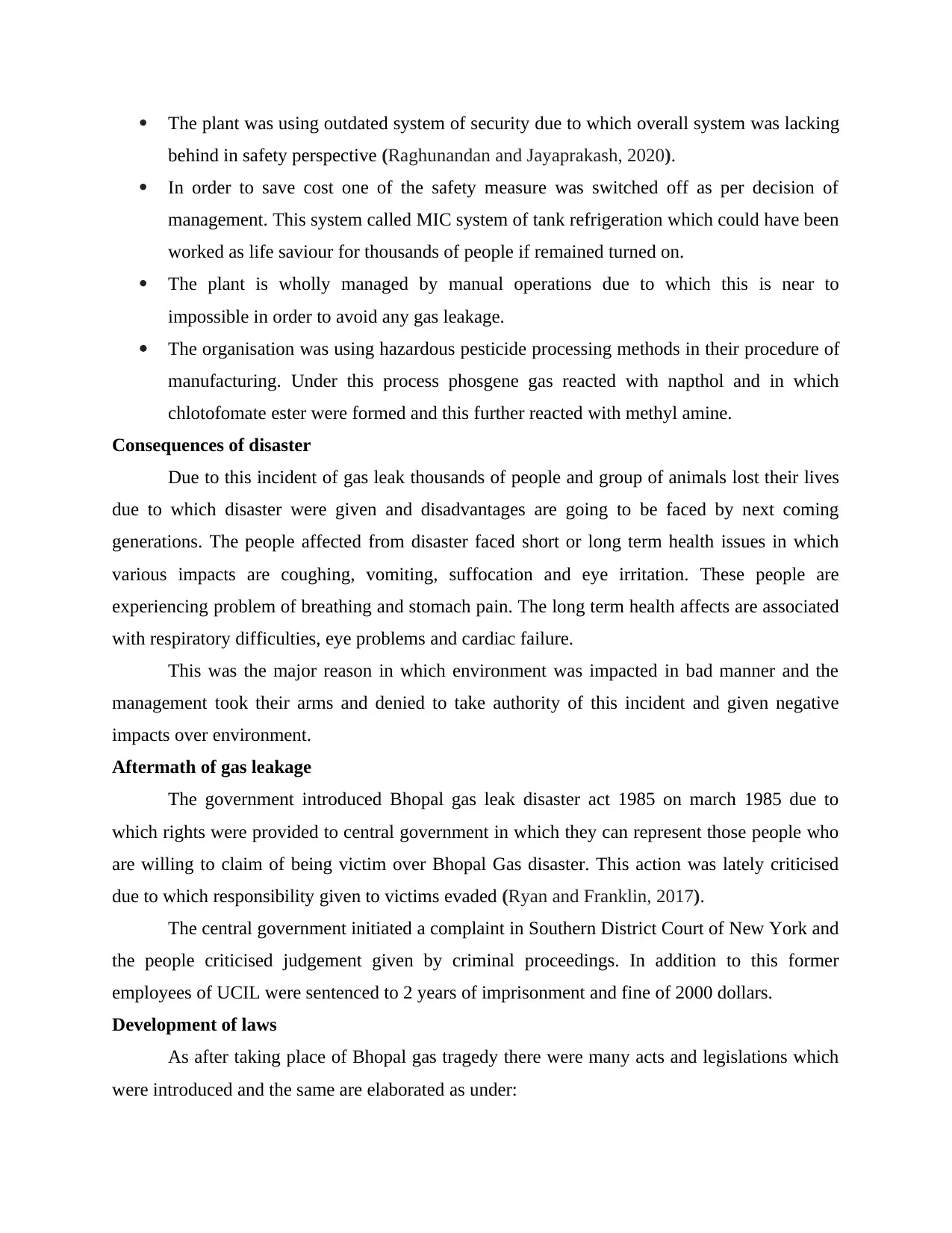
The plant was using outdated system of security due to which overall system was lacking
behind in safety perspective (Raghunandan and Jayaprakash, 2020).
In order to save cost one of the safety measure was switched off as per decision of
management. This system called MIC system of tank refrigeration which could have been
worked as life saviour for thousands of people if remained turned on.
The plant is wholly managed by manual operations due to which this is near to
impossible in order to avoid any gas leakage.
The organisation was using hazardous pesticide processing methods in their procedure of
manufacturing. Under this process phosgene gas reacted with napthol and in which
chlotofomate ester were formed and this further reacted with methyl amine.
Consequences of disaster
Due to this incident of gas leak thousands of people and group of animals lost their lives
due to which disaster were given and disadvantages are going to be faced by next coming
generations. The people affected from disaster faced short or long term health issues in which
various impacts are coughing, vomiting, suffocation and eye irritation. These people are
experiencing problem of breathing and stomach pain. The long term health affects are associated
with respiratory difficulties, eye problems and cardiac failure.
This was the major reason in which environment was impacted in bad manner and the
management took their arms and denied to take authority of this incident and given negative
impacts over environment.
Aftermath of gas leakage
The government introduced Bhopal gas leak disaster act 1985 on march 1985 due to
which rights were provided to central government in which they can represent those people who
are willing to claim of being victim over Bhopal Gas disaster. This action was lately criticised
due to which responsibility given to victims evaded (Ryan and Franklin, 2017).
The central government initiated a complaint in Southern District Court of New York and
the people criticised judgement given by criminal proceedings. In addition to this former
employees of UCIL were sentenced to 2 years of imprisonment and fine of 2000 dollars.
Development of laws
As after taking place of Bhopal gas tragedy there were many acts and legislations which
were introduced and the same are elaborated as under:
behind in safety perspective (Raghunandan and Jayaprakash, 2020).
In order to save cost one of the safety measure was switched off as per decision of
management. This system called MIC system of tank refrigeration which could have been
worked as life saviour for thousands of people if remained turned on.
The plant is wholly managed by manual operations due to which this is near to
impossible in order to avoid any gas leakage.
The organisation was using hazardous pesticide processing methods in their procedure of
manufacturing. Under this process phosgene gas reacted with napthol and in which
chlotofomate ester were formed and this further reacted with methyl amine.
Consequences of disaster
Due to this incident of gas leak thousands of people and group of animals lost their lives
due to which disaster were given and disadvantages are going to be faced by next coming
generations. The people affected from disaster faced short or long term health issues in which
various impacts are coughing, vomiting, suffocation and eye irritation. These people are
experiencing problem of breathing and stomach pain. The long term health affects are associated
with respiratory difficulties, eye problems and cardiac failure.
This was the major reason in which environment was impacted in bad manner and the
management took their arms and denied to take authority of this incident and given negative
impacts over environment.
Aftermath of gas leakage
The government introduced Bhopal gas leak disaster act 1985 on march 1985 due to
which rights were provided to central government in which they can represent those people who
are willing to claim of being victim over Bhopal Gas disaster. This action was lately criticised
due to which responsibility given to victims evaded (Ryan and Franklin, 2017).
The central government initiated a complaint in Southern District Court of New York and
the people criticised judgement given by criminal proceedings. In addition to this former
employees of UCIL were sentenced to 2 years of imprisonment and fine of 2000 dollars.
Development of laws
As after taking place of Bhopal gas tragedy there were many acts and legislations which
were introduced and the same are elaborated as under:
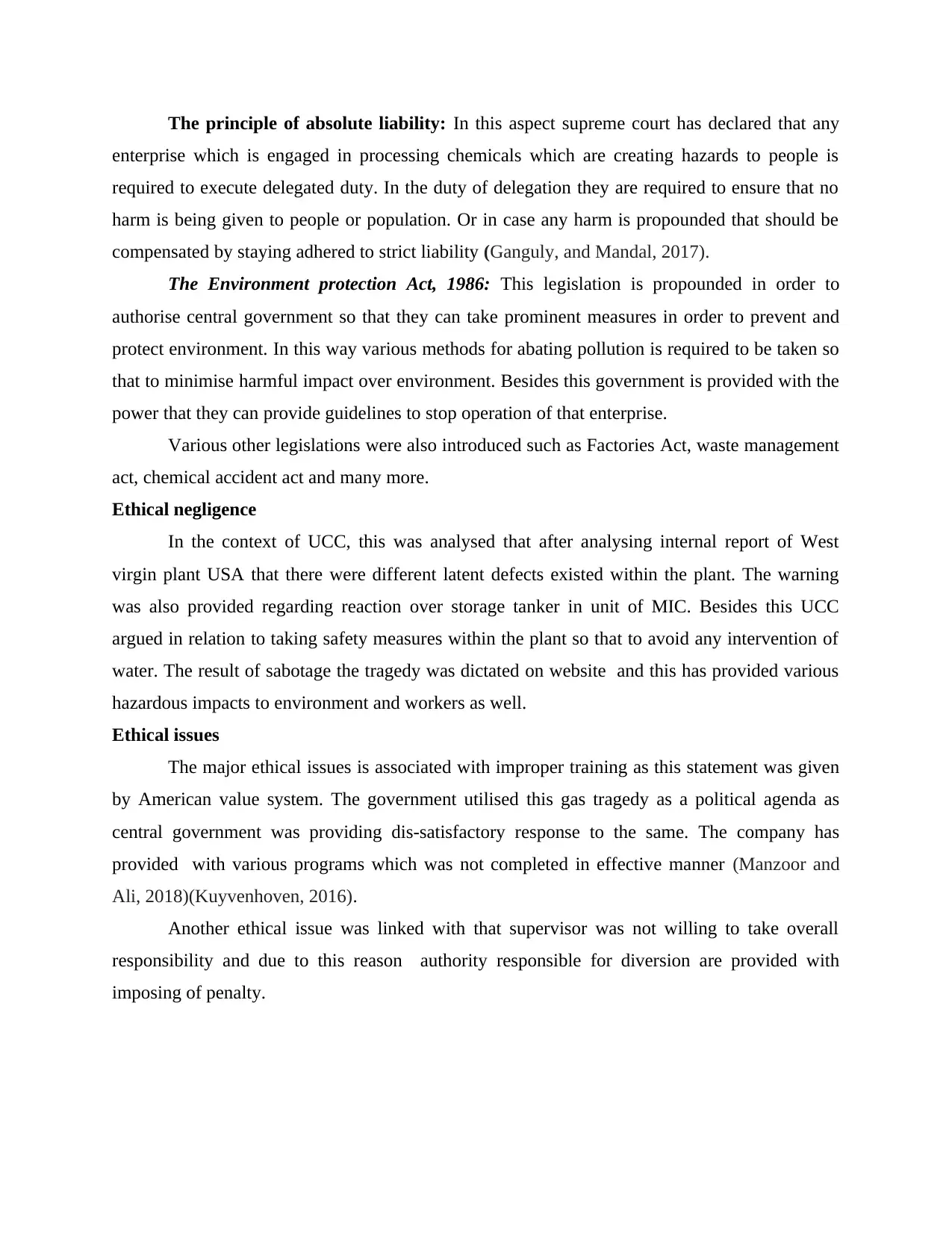
The principle of absolute liability: In this aspect supreme court has declared that any
enterprise which is engaged in processing chemicals which are creating hazards to people is
required to execute delegated duty. In the duty of delegation they are required to ensure that no
harm is being given to people or population. Or in case any harm is propounded that should be
compensated by staying adhered to strict liability (Ganguly, and Mandal, 2017).
The Environment protection Act, 1986: This legislation is propounded in order to
authorise central government so that they can take prominent measures in order to prevent and
protect environment. In this way various methods for abating pollution is required to be taken so
that to minimise harmful impact over environment. Besides this government is provided with the
power that they can provide guidelines to stop operation of that enterprise.
Various other legislations were also introduced such as Factories Act, waste management
act, chemical accident act and many more.
Ethical negligence
In the context of UCC, this was analysed that after analysing internal report of West
virgin plant USA that there were different latent defects existed within the plant. The warning
was also provided regarding reaction over storage tanker in unit of MIC. Besides this UCC
argued in relation to taking safety measures within the plant so that to avoid any intervention of
water. The result of sabotage the tragedy was dictated on website and this has provided various
hazardous impacts to environment and workers as well.
Ethical issues
The major ethical issues is associated with improper training as this statement was given
by American value system. The government utilised this gas tragedy as a political agenda as
central government was providing dis-satisfactory response to the same. The company has
provided with various programs which was not completed in effective manner (Manzoor and
Ali, 2018)(Kuyvenhoven, 2016).
Another ethical issue was linked with that supervisor was not willing to take overall
responsibility and due to this reason authority responsible for diversion are provided with
imposing of penalty.
enterprise which is engaged in processing chemicals which are creating hazards to people is
required to execute delegated duty. In the duty of delegation they are required to ensure that no
harm is being given to people or population. Or in case any harm is propounded that should be
compensated by staying adhered to strict liability (Ganguly, and Mandal, 2017).
The Environment protection Act, 1986: This legislation is propounded in order to
authorise central government so that they can take prominent measures in order to prevent and
protect environment. In this way various methods for abating pollution is required to be taken so
that to minimise harmful impact over environment. Besides this government is provided with the
power that they can provide guidelines to stop operation of that enterprise.
Various other legislations were also introduced such as Factories Act, waste management
act, chemical accident act and many more.
Ethical negligence
In the context of UCC, this was analysed that after analysing internal report of West
virgin plant USA that there were different latent defects existed within the plant. The warning
was also provided regarding reaction over storage tanker in unit of MIC. Besides this UCC
argued in relation to taking safety measures within the plant so that to avoid any intervention of
water. The result of sabotage the tragedy was dictated on website and this has provided various
hazardous impacts to environment and workers as well.
Ethical issues
The major ethical issues is associated with improper training as this statement was given
by American value system. The government utilised this gas tragedy as a political agenda as
central government was providing dis-satisfactory response to the same. The company has
provided with various programs which was not completed in effective manner (Manzoor and
Ali, 2018)(Kuyvenhoven, 2016).
Another ethical issue was linked with that supervisor was not willing to take overall
responsibility and due to this reason authority responsible for diversion are provided with
imposing of penalty.
⊘ This is a preview!⊘
Do you want full access?
Subscribe today to unlock all pages.

Trusted by 1+ million students worldwide
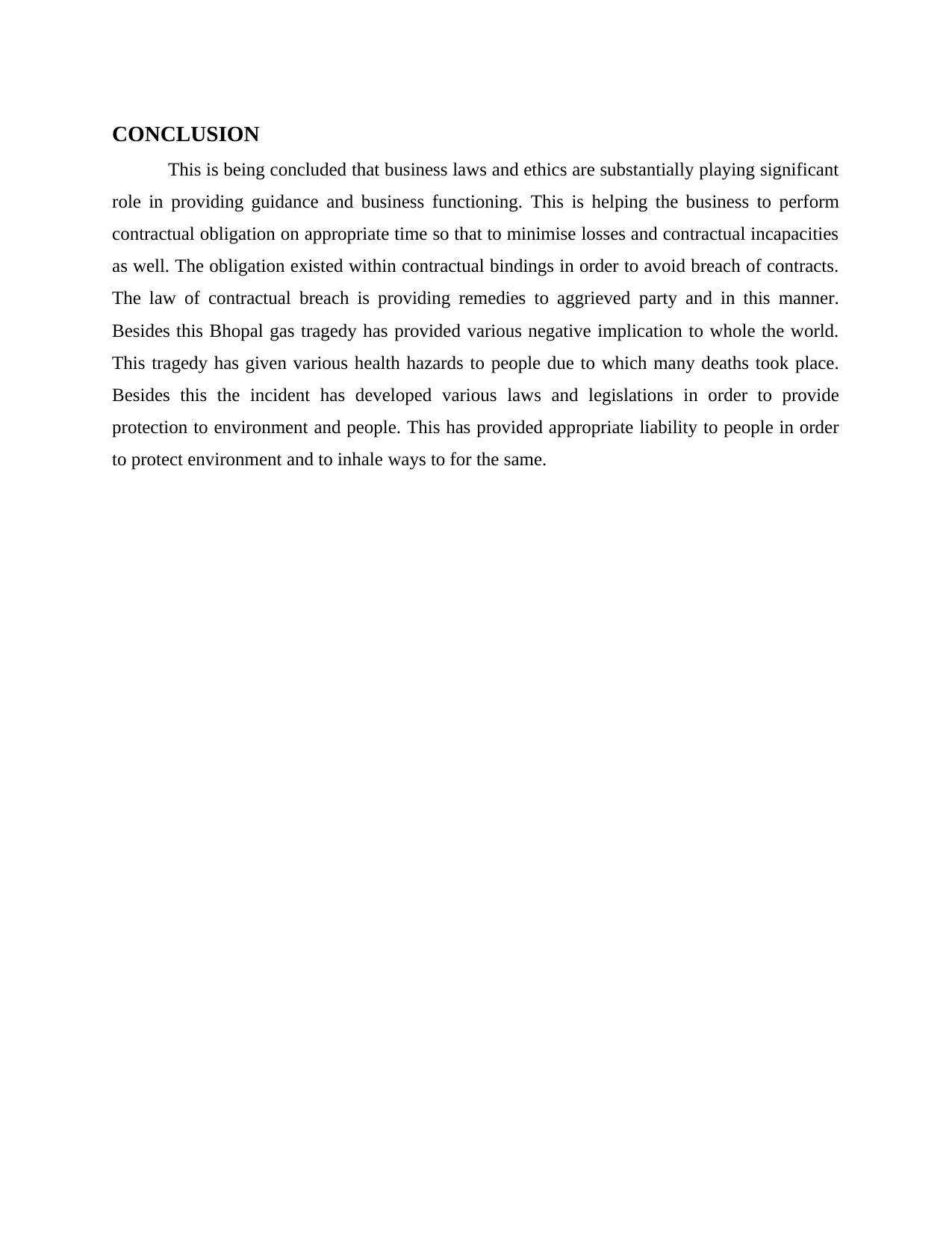
CONCLUSION
This is being concluded that business laws and ethics are substantially playing significant
role in providing guidance and business functioning. This is helping the business to perform
contractual obligation on appropriate time so that to minimise losses and contractual incapacities
as well. The obligation existed within contractual bindings in order to avoid breach of contracts.
The law of contractual breach is providing remedies to aggrieved party and in this manner.
Besides this Bhopal gas tragedy has provided various negative implication to whole the world.
This tragedy has given various health hazards to people due to which many deaths took place.
Besides this the incident has developed various laws and legislations in order to provide
protection to environment and people. This has provided appropriate liability to people in order
to protect environment and to inhale ways to for the same.
This is being concluded that business laws and ethics are substantially playing significant
role in providing guidance and business functioning. This is helping the business to perform
contractual obligation on appropriate time so that to minimise losses and contractual incapacities
as well. The obligation existed within contractual bindings in order to avoid breach of contracts.
The law of contractual breach is providing remedies to aggrieved party and in this manner.
Besides this Bhopal gas tragedy has provided various negative implication to whole the world.
This tragedy has given various health hazards to people due to which many deaths took place.
Besides this the incident has developed various laws and legislations in order to provide
protection to environment and people. This has provided appropriate liability to people in order
to protect environment and to inhale ways to for the same.
Paraphrase This Document
Need a fresh take? Get an instant paraphrase of this document with our AI Paraphraser
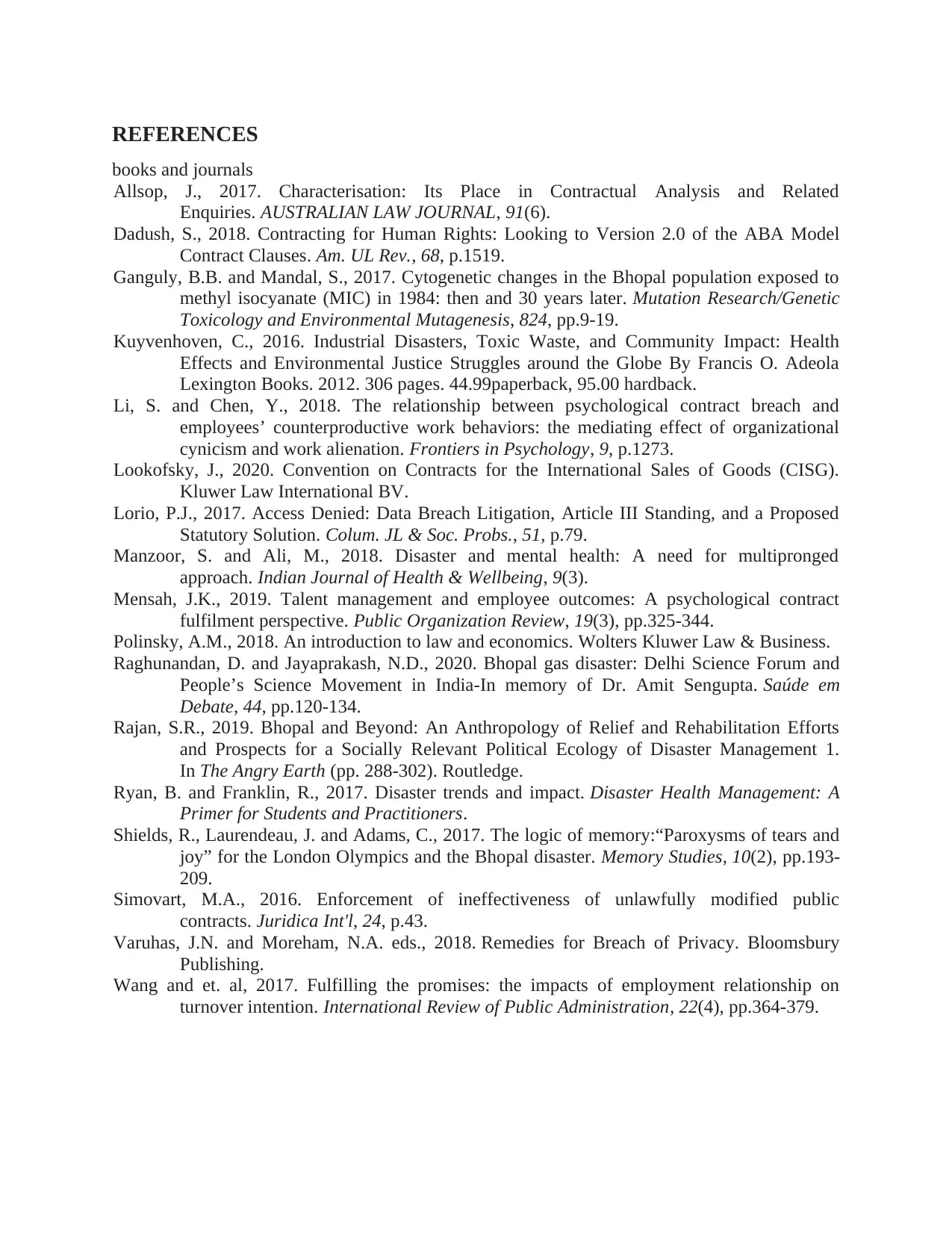
REFERENCES
books and journals
Allsop, J., 2017. Characterisation: Its Place in Contractual Analysis and Related
Enquiries. AUSTRALIAN LAW JOURNAL, 91(6).
Dadush, S., 2018. Contracting for Human Rights: Looking to Version 2.0 of the ABA Model
Contract Clauses. Am. UL Rev., 68, p.1519.
Ganguly, B.B. and Mandal, S., 2017. Cytogenetic changes in the Bhopal population exposed to
methyl isocyanate (MIC) in 1984: then and 30 years later. Mutation Research/Genetic
Toxicology and Environmental Mutagenesis, 824, pp.9-19.
Kuyvenhoven, C., 2016. Industrial Disasters, Toxic Waste, and Community Impact: Health
Effects and Environmental Justice Struggles around the Globe By Francis O. Adeola
Lexington Books. 2012. 306 pages. 44.99paperback, 95.00 hardback.
Li, S. and Chen, Y., 2018. The relationship between psychological contract breach and
employees’ counterproductive work behaviors: the mediating effect of organizational
cynicism and work alienation. Frontiers in Psychology, 9, p.1273.
Lookofsky, J., 2020. Convention on Contracts for the International Sales of Goods (CISG).
Kluwer Law International BV.
Lorio, P.J., 2017. Access Denied: Data Breach Litigation, Article III Standing, and a Proposed
Statutory Solution. Colum. JL & Soc. Probs., 51, p.79.
Manzoor, S. and Ali, M., 2018. Disaster and mental health: A need for multipronged
approach. Indian Journal of Health & Wellbeing, 9(3).
Mensah, J.K., 2019. Talent management and employee outcomes: A psychological contract
fulfilment perspective. Public Organization Review, 19(3), pp.325-344.
Polinsky, A.M., 2018. An introduction to law and economics. Wolters Kluwer Law & Business.
Raghunandan, D. and Jayaprakash, N.D., 2020. Bhopal gas disaster: Delhi Science Forum and
People’s Science Movement in India-In memory of Dr. Amit Sengupta. Saúde em
Debate, 44, pp.120-134.
Rajan, S.R., 2019. Bhopal and Beyond: An Anthropology of Relief and Rehabilitation Efforts
and Prospects for a Socially Relevant Political Ecology of Disaster Management 1.
In The Angry Earth (pp. 288-302). Routledge.
Ryan, B. and Franklin, R., 2017. Disaster trends and impact. Disaster Health Management: A
Primer for Students and Practitioners.
Shields, R., Laurendeau, J. and Adams, C., 2017. The logic of memory:“Paroxysms of tears and
joy” for the London Olympics and the Bhopal disaster. Memory Studies, 10(2), pp.193-
209.
Simovart, M.A., 2016. Enforcement of ineffectiveness of unlawfully modified public
contracts. Juridica Int'l, 24, p.43.
Varuhas, J.N. and Moreham, N.A. eds., 2018. Remedies for Breach of Privacy. Bloomsbury
Publishing.
Wang and et. al, 2017. Fulfilling the promises: the impacts of employment relationship on
turnover intention. International Review of Public Administration, 22(4), pp.364-379.
books and journals
Allsop, J., 2017. Characterisation: Its Place in Contractual Analysis and Related
Enquiries. AUSTRALIAN LAW JOURNAL, 91(6).
Dadush, S., 2018. Contracting for Human Rights: Looking to Version 2.0 of the ABA Model
Contract Clauses. Am. UL Rev., 68, p.1519.
Ganguly, B.B. and Mandal, S., 2017. Cytogenetic changes in the Bhopal population exposed to
methyl isocyanate (MIC) in 1984: then and 30 years later. Mutation Research/Genetic
Toxicology and Environmental Mutagenesis, 824, pp.9-19.
Kuyvenhoven, C., 2016. Industrial Disasters, Toxic Waste, and Community Impact: Health
Effects and Environmental Justice Struggles around the Globe By Francis O. Adeola
Lexington Books. 2012. 306 pages. 44.99paperback, 95.00 hardback.
Li, S. and Chen, Y., 2018. The relationship between psychological contract breach and
employees’ counterproductive work behaviors: the mediating effect of organizational
cynicism and work alienation. Frontiers in Psychology, 9, p.1273.
Lookofsky, J., 2020. Convention on Contracts for the International Sales of Goods (CISG).
Kluwer Law International BV.
Lorio, P.J., 2017. Access Denied: Data Breach Litigation, Article III Standing, and a Proposed
Statutory Solution. Colum. JL & Soc. Probs., 51, p.79.
Manzoor, S. and Ali, M., 2018. Disaster and mental health: A need for multipronged
approach. Indian Journal of Health & Wellbeing, 9(3).
Mensah, J.K., 2019. Talent management and employee outcomes: A psychological contract
fulfilment perspective. Public Organization Review, 19(3), pp.325-344.
Polinsky, A.M., 2018. An introduction to law and economics. Wolters Kluwer Law & Business.
Raghunandan, D. and Jayaprakash, N.D., 2020. Bhopal gas disaster: Delhi Science Forum and
People’s Science Movement in India-In memory of Dr. Amit Sengupta. Saúde em
Debate, 44, pp.120-134.
Rajan, S.R., 2019. Bhopal and Beyond: An Anthropology of Relief and Rehabilitation Efforts
and Prospects for a Socially Relevant Political Ecology of Disaster Management 1.
In The Angry Earth (pp. 288-302). Routledge.
Ryan, B. and Franklin, R., 2017. Disaster trends and impact. Disaster Health Management: A
Primer for Students and Practitioners.
Shields, R., Laurendeau, J. and Adams, C., 2017. The logic of memory:“Paroxysms of tears and
joy” for the London Olympics and the Bhopal disaster. Memory Studies, 10(2), pp.193-
209.
Simovart, M.A., 2016. Enforcement of ineffectiveness of unlawfully modified public
contracts. Juridica Int'l, 24, p.43.
Varuhas, J.N. and Moreham, N.A. eds., 2018. Remedies for Breach of Privacy. Bloomsbury
Publishing.
Wang and et. al, 2017. Fulfilling the promises: the impacts of employment relationship on
turnover intention. International Review of Public Administration, 22(4), pp.364-379.
1 out of 11
Related Documents
Your All-in-One AI-Powered Toolkit for Academic Success.
+13062052269
info@desklib.com
Available 24*7 on WhatsApp / Email
![[object Object]](/_next/static/media/star-bottom.7253800d.svg)
Unlock your academic potential
Copyright © 2020–2025 A2Z Services. All Rights Reserved. Developed and managed by ZUCOL.





